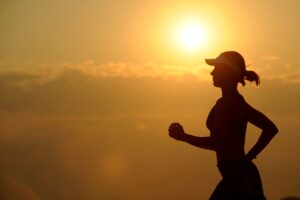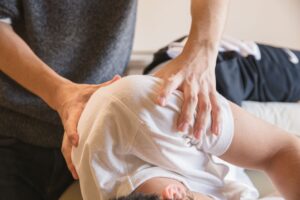In order for health to be achieved and maintained, we obviously must have a proper balance between rest and activity. If we rest too much and don’t balance our rest with the proper amount of physical activity, we will never achieve and maintain our true health potential!
Exercise is essential in maintaining our body weight, strength and tone. It also ensures proper blood supply to every part of the body, keeps the lymph moving normally and maintains the general health of your en- tire system! Exercise serves to strengthen and nourish all the various organs and systems of the body.
When exercise is neglected, all the various muscles, organs, glands and the circulatory and respiratory systems become weakened and sluggish, leading to a decrease in physiological efficiency.
Exercise is much more than simply developing strong muscles. It is body˜building in the complete sense of the term. Every cell and fibre is involved. The heart, kidneys, liver, skin, hair, eyes, etc., including the brain and nervous system, are stimulated and strengthened in their various functions. The tone and quality of the entire system is improved.
The skeletal system, for example, depends upon exercise in order to maintain its size, strength, and physiological functions. When a specific part of the body is put into action, the body responds by sending more blood, nutrients, and nerve energy to that part.. With more exercise, body metabolism is increased and there is a consequent improvement in muscle tone and health of the organ tissues involved. Exercise is the most effective and efficient means for bringing about this result throughout the entire system. At one point during the history of man, our ancestors were forced to produce great amounts of physical exertion in order to survive.
But as civilisation has grown and developed, and with technology creating more sedentary jobs, a large proportion of society now reaches maturity without experiencing a great deal of physical exercise at all! As a result, the western world have become fat and flabby weaklings, growing old prematurely and suffering a great deal from the ill effects produced from physical inactivity. The bottom line is that the importance of exercise can never be overemphasised.
There are so many ways to get moving and find 30 minutes each day that there simply is no excuse! Exercise decreases nervous tension, increases mental clarity, leads to more efficient use of organs and systems, produces more energy, endurance and flexibility! Whatever forms of physical activity we are involved in, it must influence the entire body in a balanced manner.
EFFECTS OF EXERCISE ON THE BODY SYSTEMS
THE MUSCULOSKELETAL SYSTEM
The human body is composed of many different individual muscles, each with its own particular job to do. The mass of skeletal muscles in the body may be looked upon as one large organ of movement, which makes up about 40% of our total body weight. Skeletal muscles allow our bodies to adapt to whatever situation arises in our environment.
The muscular system helps to maintain proper physical posture as well as counter balancing the negative effects of gravity. Depending upon what their duties are, muscles function in groups. Muscles function like one large organ, the instantaneous distribution of activity is continuously changing as the individual muscles are called into action or released into passivity, depending upon how our central nervous system commands our response to the particular activity. All skeletal muscles in the body are made up of numerous muscle fibres.
Each muscle fibre is innervated by a mixed nerve (motor and sensory) located in the middle of the fibre. Though it is possible to develop individual muscle groups with specific exercises, this can cause an imbalance with various other muscle groups that are not simultaneously developed. Therefore, it is important to practice balanced and consistent exercise which will pro- vide the necessary strength, flexibility and endurance to the entire muscular system.
The end result will be a muscular system that is highly developed and functioning in harmony with all the other systems of the body.
THE RESPIRATORY SYSTEM
The lungs are expanded and contracted by the movement of the diaphragm and by elevation and depression of the ribs. During respiration, oxygen is taken into the lungs from the atmosphere. In the lungs, oxygen is exchanged with CO2 (waste product from cell metabolism) from the blood- stream.
The oxygen is carried to all the tissues in the body in order to nourish and provide the necessary component for developing energy necessary for cell functioning. During strenuous exercise, the diffusing capacity for oxygen increases about three fold. In order for this to happen, more blood vessels must be- come available, creating more surface area for the gaseous exchange between the lungs and the blood.
Dilation or expansion of all blood vessels occurs, then stretching of the lung surface responsible for gaseous exchange occurs, thus making the walls thinner for gas exchanges and increasing the surface area. With exercise, the lungs be- come stronger, more resilient and much more efficient. More tissues in the body are oxygenated while simultaneously more blood vessels and lung tissue are utilised. The lungs are inter- dependent upon all the other systems of the body.
Only when all the systems are functioning smoothly and efficiently can we achieve high levels of health and enjoyment from that.
THE CARDIOVASCULAR SYSTEM
The heart, like any other muscle, can be strengthened or weakened, depending upon the amount of activity or exercise it experiences. According to Starling’s Law, the heart is an automatic pump that is capable of pumping far more than the normal value of 5 litres per minute of blood which returns from peripheral circulation.
Exercise greatly increases the effectiveness of the heart providing blood and therefore oxygen and other vital nutrients to all cells and tissues of the body. Before exercise begins, the autonomic nervous system is stimulated by the thought of exercise. This stimulation in- creases the heart pump and prepares the body for physical activity.
At the onset of exercise, the blood vessels of the muscles become dilated (expand), due to the signals transmitted from the motor cortex to the sympathetic nervous system. This instantaneously increases the cardiac output (blood pumped out by the heart). The direct effect of increased metabolism in the muscles causes an increased use of oxygen and other nutrients, increasing local blood flow tremendously improving your health!
EXERCISE AND NUTRITION
We must consider that some foods convert into calories at a higher rate than others. For instance, simple sugars contained in fruits convert to calories more readily and thus don’t provide energy for a long period of time, compared to complex sugars contained in many vegetables and legumes, which are more slowly converted and burned into calories.
Meat and dairy products are even more slowly broken down and converted and cause a lot of wear and tear on the digestive organs. In this respect, a diet centred around fresh fruits, vegetables and a small amount of nuts and seeds is far superior to a diet centred purely around meat and dairy products. Some of the first accounts of athletics and nutrition go back to the early Olympic Games in Greece.
It was indicated (Harris, H.S., 1966) that there was a considerable insistence by Greek doctors on the importance of the diet, that led to a keen interest in the diet of their athletes. Very little meat was originally consumed in Greece. The diet consisted of whole grains such as barley or wheat, eaten in cereal or bread form, and a variety of vegetables, such as onions, carrots, cucumbers, marrows, beans and various green leafy vegetables. Fruit was abundant, especially grapes and figs, apples, pears and nuts. The pomegranate was a prize. Although the Greeks did consume large amounts of goat milk products, adequate nutritional requirements were contained within the former food groups.
During the 1900’s there  developed the popular belief that any form of sustained muscular exercise required an abundance of meat foods. It was suggested that during exercise the substance of the muscle was consumed and therefore hard work would remove a considerable portion of the muscle material that could only be replaced by eating animal protein.
It has since been proven, however, that it is only when the muscles are chronically inactive or during starvation that the muscle tissue is actually˜used up. Energy requirements for exercise are dependent upon the amount and type of exercise you are doing! But in addition to this, energy requirements vary widely with age. A new- born baby requires less total energy than a full-grown adult.. Society is obsessed with caloric intake, sometimes with total disregard to the quality and composition of the foods which are consumed.
There is much controversy about the composition of diet for athletes. Much of the controversy concerns the amounts of protein, fat and carbohydrates consumed and their relationship to exercise and athletic performance. Whether an excess of the three nutrient groups (carbohydrates, fats, proteins) is more important than any of the others when dealing with activity, it can be argued that all three substances are equally important.
Though recent trends in nutritional advice tend to overemphasise protein, all protein in our bodies does not come from outside protein sources. There is a constant interchange of carbohydrates, fats and proteins within our bodies. Food is used not only for the development of the body, but also for the energy expended in daily exercise and activity. Though carbohydrates and proteins are somewhat interchangeable, carbohydrates are more readily required in volume during physical exercise than proteins.
For the most efficiency in exercise and for physical exertion, we need a good deal of both simple and complex carbohydrates in our daily diet. Through the gradual decomposition of simple sugars and complex sugars or carbohydrates, our metabolism and activity level is sustained. Therefore, it seems that the ideal diet for an active person or an athlete is based on fresh fruits, vegetables (including leafy green vegetables and roots to maintain the necessary amount of protein and calcium), nuts and seeds.



